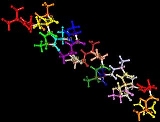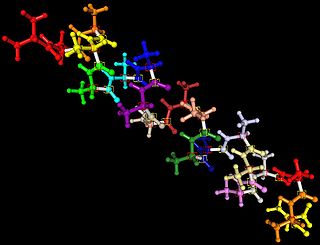
Fragment Molecular Orbital
Encyclopedia
The fragment molecular orbital method (FMO) is a computational method that can compute very large molecular systems with thousands of atoms using ab initio quantum-chemical wave functions.
 The fragment molecular orbital method (FMO) was developed by K. Kitaura and coworkers in 1999. FMO is deeply interconnected with the energy decomposition analysis (EDA) by Kitaura and Morokuma, developed in 1976. The main use of FMO is to compute very large molecular systems by dividing them into fragments and performing ab initio or density functional quantum-mechanical calculations of fragments and their dimers, whereby the Coulomb field from the whole system is included. The latter feature allows fragment calculations without using caps.
The fragment molecular orbital method (FMO) was developed by K. Kitaura and coworkers in 1999. FMO is deeply interconnected with the energy decomposition analysis (EDA) by Kitaura and Morokuma, developed in 1976. The main use of FMO is to compute very large molecular systems by dividing them into fragments and performing ab initio or density functional quantum-mechanical calculations of fragments and their dimers, whereby the Coulomb field from the whole system is included. The latter feature allows fragment calculations without using caps.
Earlier, there had been other methods related to FMO including the incremental correlation method by H. Stoll (1992). Also FMO bears some similarity to the method by J. Gao (1997), the applicability of which for condensed phase systems was subsequently demonstrated by carrying out a statistical mechanical Monte Carlo simulation of liquid water in 1998; this method was later re-named as the explicit polarization (X-Pol) theory. The incremental method uses formally the same many-body expansion of properties as FMO, although the exact meaning of terms is different. The difference between X-Pol and FMO is in the approximation for estimating the pair interactions between fragments. X-Pol is closely related to the one-body expansion used in FMO (FMO1) in terms of the electrostatics, but other interactions are treated differently.
Later, other methods closely related to FMO were proposed including the kernel energy method of L. Huang and the electrostatically embedded many-body expansion by E. Dahlke,
S. Hirata and later M. Kamiya suggested approaches also very closely related to FMO.
energy gradient, dipole moment etc, the pair interaction is obtained for
each pair of fragments. This pair interaction energy can be further
decomposed into electrostatic, exchange, charge transfer and dispersion
contributions. This analysis is known as the pair interaction energy
decomposition analysis (PIEDA) and it can be thought of as FMO-based EDA.
Alternatively, configuration analysis for fragment interaction (CAFI) and fragment interaction analysis based on local MP2 (FILM) were suggested within the FMO framework.
The rapid development of the FMO method made possible to use common
wave functions for ab initio calculations of fragments and their dimers,
such as Hartree-Fock
, Density functional theory
(DFT),
Multi-configurational self-consistent field
(MCSCF),
time-dependent DFT (TDDFT), configuration interaction
(CI),
second order Møller-Plesset perturbation theory
(MP2), and
coupled cluster
(CC). The solvent effects can be treated with the Polarizable continuum model
(PCM). The FMO code is very efficiently parallelized utilising the generalized distributed data interface (GDDI) and hundreds of CPUs can be used with nearly perfect scaling.
Since very large systems can be computed with high level ab initio
wave functions, FMO is thought to be very useful for biological
applications to compute the whole proteins and their complexes.
In 2005, an application of FMO to the calculation of the ground electronic state of photosynthetic protein with more than 20,000 atoms was
distinguished with the best technical paper award at Supercomputing 2005.
A number of applications of FMO to biochemical problems have been
published.
In particular, the FMO method is a promising tool for molecular clusters, Drug design
, quantitative structure-activity relationship (QSAR) as well as
the studies of excited states and chemical reactions of biological
systems. In the recent development (2008), the adaptive frozen orbital (AFO) treatment of the
detached bonds was suggested for FMO, making it possible to study solids and surfaces. FMO-TDDFT was
also applied to the excited states of molecular crystals (quinacridone).
The FMO method is implemented in GAMESS (US)
and ABINIT-MP software packages. Both are distributed free of charge. The preparation of the
input files is facilitated with the FMOutil software.
The X-Pol method has been implemented into the program CHARMM for biomolecular
and condensed phase simulations.
In addition, graphical user interface Facio developed
by Pr M. Suenaga has a very convenient specialised support of FMO (in addition to
other features), with which an automatic fragmentation of molecular clusters, proteins, nucleotides, saccharides and any combination thereof (e.g., DNA and protein complexes in explicit solvent)
can be done in a few minutes, and a manual fragmentation of solids and surfaces can be accomplished by clicking the bonds to be detached. Facio can also visualise results of FMO calculations, such as the pair interactions.
In the recent FMO book, one can find 10 illustrated chapters written by the experts in the FMO development and applications, as well as a CDROM with
annotated samples of input and output files, Facio modelling software and video tutorials (AppliGuide movies, showing mouse clicks) for treating difficult PDB files with Facio.
FMO implementation in GAMESS
(E - energy, G - gradient, e and g - respectively the same, but in the development version soon to be released; bold - can be used with PCM)
History of FMO and related methods

Earlier, there had been other methods related to FMO including the incremental correlation method by H. Stoll (1992). Also FMO bears some similarity to the method by J. Gao (1997), the applicability of which for condensed phase systems was subsequently demonstrated by carrying out a statistical mechanical Monte Carlo simulation of liquid water in 1998; this method was later re-named as the explicit polarization (X-Pol) theory. The incremental method uses formally the same many-body expansion of properties as FMO, although the exact meaning of terms is different. The difference between X-Pol and FMO is in the approximation for estimating the pair interactions between fragments. X-Pol is closely related to the one-body expansion used in FMO (FMO1) in terms of the electrostatics, but other interactions are treated differently.
Later, other methods closely related to FMO were proposed including the kernel energy method of L. Huang and the electrostatically embedded many-body expansion by E. Dahlke,
S. Hirata and later M. Kamiya suggested approaches also very closely related to FMO.
Introduction to FMO
In addition to the calculation of the total properties, such as the energy,energy gradient, dipole moment etc, the pair interaction is obtained for
each pair of fragments. This pair interaction energy can be further
decomposed into electrostatic, exchange, charge transfer and dispersion
contributions. This analysis is known as the pair interaction energy
decomposition analysis (PIEDA) and it can be thought of as FMO-based EDA.
Alternatively, configuration analysis for fragment interaction (CAFI) and fragment interaction analysis based on local MP2 (FILM) were suggested within the FMO framework.
The rapid development of the FMO method made possible to use common
wave functions for ab initio calculations of fragments and their dimers,
such as Hartree-Fock
Hartree-Fock
In computational physics and chemistry, the Hartree–Fock method is an approximate method for the determination of the ground-state wave function and ground-state energy of a quantum many-body system....
, Density functional theory
Density functional theory
Density functional theory is a quantum mechanical modelling method used in physics and chemistry to investigate the electronic structure of many-body systems, in particular atoms, molecules, and the condensed phases. With this theory, the properties of a many-electron system can be determined by...
(DFT),
Multi-configurational self-consistent field
Multi-configurational self-consistent field
Multi-configurational self-consistent field is a method in quantum chemistry used to generate qualitatively correct reference states of molecules in cases where Hartree–Fock and density functional theory are not adequate...
(MCSCF),
time-dependent DFT (TDDFT), configuration interaction
Configuration interaction
Configuration interaction is a post-Hartree–Fock linear variational method for solving the nonrelativistic Schrödinger equation within the Born–Oppenheimer approximation for a quantum chemical multi-electron system. Mathematically, configuration simply describes the linear combination...
(CI),
second order Møller-Plesset perturbation theory
Møller-Plesset perturbation theory
Møller–Plesset perturbation theory is one of several quantum chemistry post-Hartree–Fock ab initio methods in the field of computational chemistry...
(MP2), and
coupled cluster
Coupled cluster
Coupled cluster is a numerical technique used for describing many-body systems. Its most common use is as one of several quantum chemical post-Hartree–Fock ab initio quantum chemistry methods in the field of computational chemistry...
(CC). The solvent effects can be treated with the Polarizable continuum model
Polarizable continuum model
The polarizable continuum model is a commonly used method in computational chemistry to model solvation effects. If it were necessary to consider each solvent molecule as a separate molecule, the computational cost of modeling a solvent-mediated chemical reaction would grow prohibitively high...
(PCM). The FMO code is very efficiently parallelized utilising the generalized distributed data interface (GDDI) and hundreds of CPUs can be used with nearly perfect scaling.
Since very large systems can be computed with high level ab initio
wave functions, FMO is thought to be very useful for biological
applications to compute the whole proteins and their complexes.
In 2005, an application of FMO to the calculation of the ground electronic state of photosynthetic protein with more than 20,000 atoms was
distinguished with the best technical paper award at Supercomputing 2005.
A number of applications of FMO to biochemical problems have been
published.
In particular, the FMO method is a promising tool for molecular clusters, Drug design
Drug design
Drug design, also sometimes referred to as rational drug design or structure-based drug design, is the inventive process of finding new medications based on the knowledge of the biological target...
, quantitative structure-activity relationship (QSAR) as well as
the studies of excited states and chemical reactions of biological
systems. In the recent development (2008), the adaptive frozen orbital (AFO) treatment of the
detached bonds was suggested for FMO, making it possible to study solids and surfaces. FMO-TDDFT was
also applied to the excited states of molecular crystals (quinacridone).
The FMO method is implemented in GAMESS (US)
GAMESS (US)
GAMESS is a computational chemistry software program that stands for General Atomic and Molecular Electronic Structure System. The original code started on October 1, 1977 as a National Resources for Computations in Chemistry project. In 1981, the code base split into GAMESS and GAMESS variants,...
and ABINIT-MP software packages. Both are distributed free of charge. The preparation of the
input files is facilitated with the FMOutil software.
The X-Pol method has been implemented into the program CHARMM for biomolecular
and condensed phase simulations.
In addition, graphical user interface Facio developed
by Pr M. Suenaga has a very convenient specialised support of FMO (in addition to
other features), with which an automatic fragmentation of molecular clusters, proteins, nucleotides, saccharides and any combination thereof (e.g., DNA and protein complexes in explicit solvent)
can be done in a few minutes, and a manual fragmentation of solids and surfaces can be accomplished by clicking the bonds to be detached. Facio can also visualise results of FMO calculations, such as the pair interactions.
In the recent FMO book, one can find 10 illustrated chapters written by the experts in the FMO development and applications, as well as a CDROM with
annotated samples of input and output files, Facio modelling software and video tutorials (AppliGuide movies, showing mouse clicks) for treating difficult PDB files with Facio.
FMO implementation in GAMESS
(E - energy, G - gradient, e and g - respectively the same, but in the development version soon to be released; bold - can be used with PCM)
|

